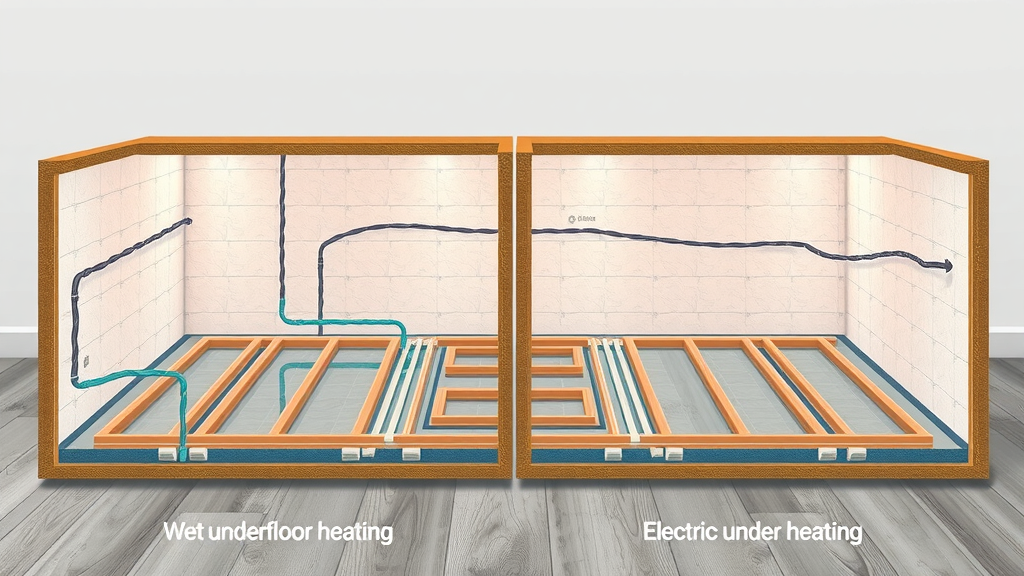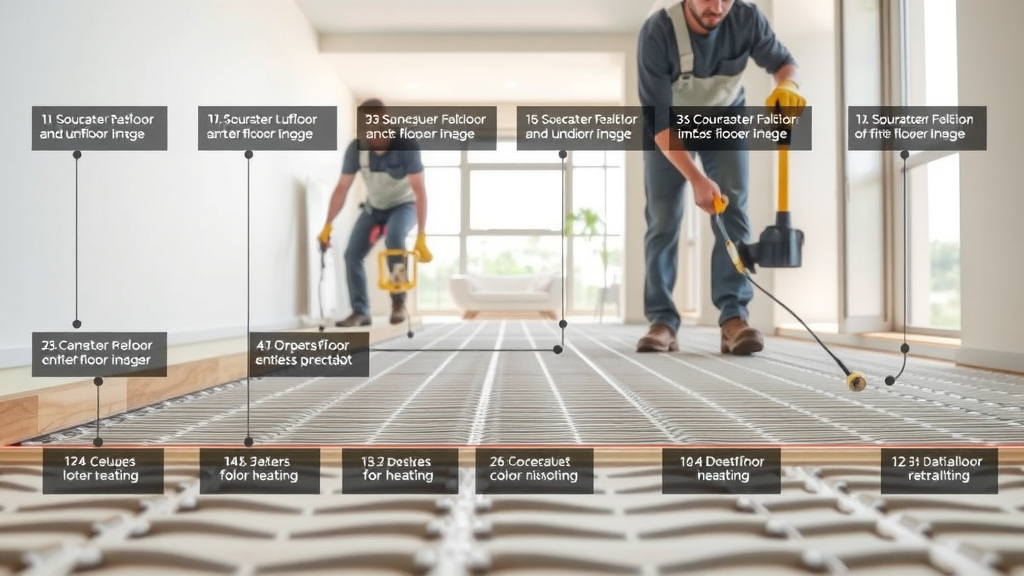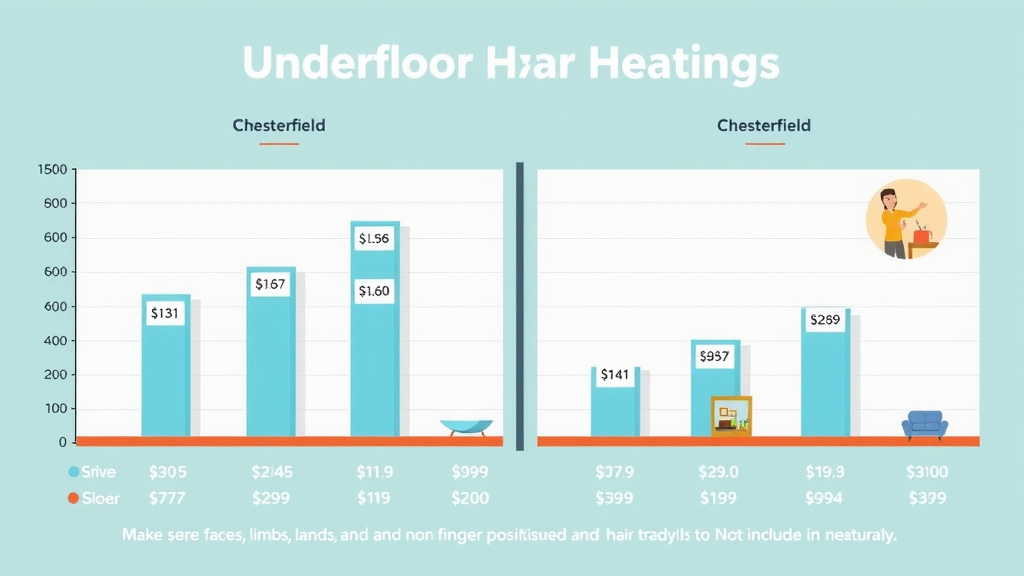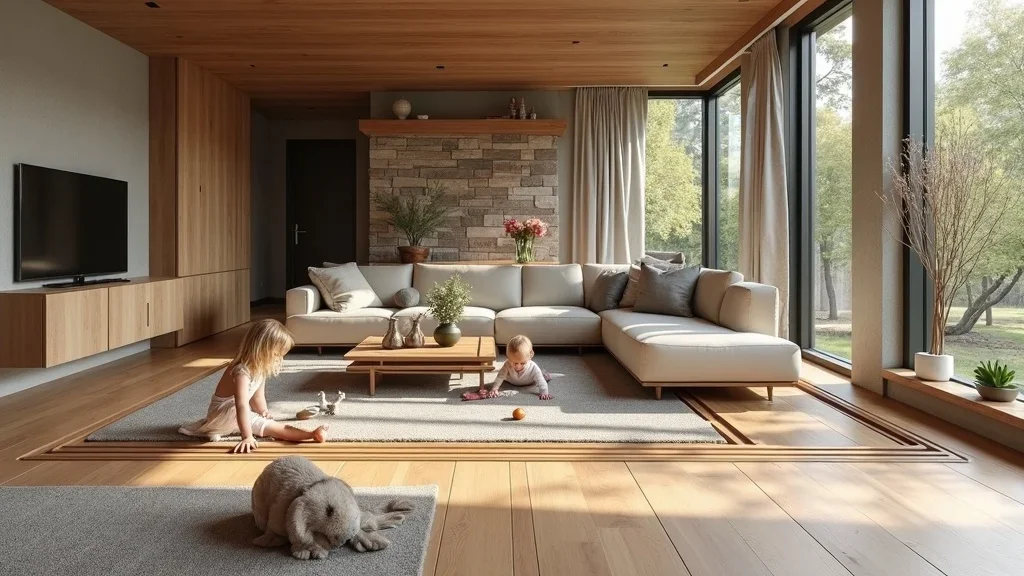Did you know that homes with underfloor heating in Chesterfield can cut heating costs by up to 25% compared to traditional radiators? That’s more than just comfort—it’s a smart investment. If you’re considering upgrading your home’s warmth and value, understanding the real underfloor heating cost in Chesterfield is crucial before you take the plunge. This guide provides all the facts, figures, pros, and possible pitfalls so you can invest wisely and enjoy a cosier, more energy-efficient home.

Revealing Underfloor Heating Cost Chesterfield with Surprising Facts
Thinking about underfloor heating in Chesterfield? You’re not alone. As energy prices continue to rise and more people seek energy-efficient, future-proof solutions, underfloor heating systems are gaining popularity across Chesterfield. But what’s driving this surge, and how much should you really expect to invest? The underfloor heating cost Chesterfield isn’t just about the installation—it’s about long-term savings, comfort, and flexibility for your home’s heating system.
Whether you live in a period property or a brand-new build, understanding the different types of floor heating systems—and their associated costs—is essential. Let’s peel back the layers on what factors impact the true cost. From system choices like wet underfloor heating versus electric underfloor heating , to energy prices, room sizes, and even installer experience, each variable plays a big part in your final bill. Don’t let confusion (or hidden charges) stand between you and a warmer home!
A 2024 Market Snapshot: Floor Heating and Its Growing Popularity in Chesterfield
Today, more Chesterfield households are turning to underfloor heating not just for its luxurious comfort, but out of necessity. With predictions of energy costs climbing further in 2024, interest in energy-efficient heating solutions has soared. Local underfloor heating installers are reporting up to 40% more inquiries than last year alone.
This spike is due in part to advances in floor heating systems —especially those designed to work efficiently with air source or ground source heat pumps . These systems deliver lower and more stable heating costs over time. Whether opting for wet underfloor heating systems (using warm water) or electric variants, Chesterfield homeowners value their flexibility, compatibility with renewable technologies, and future-proof appeal.
Key reasons why underfloor heating is surging in demand
- Energy-efficient heating reduces monthly bills and helps meet government green targets.
- Invisible warmth means no bulky radiators, freeing up space and improving home aesthetics.
- Ideal for modern open-plan layouts and suitable for nearly every floor covering.
- Partners well with central heating and renewable tech, such as heat pumps.
- Consistent, even warmth provides unmatched comfort underfoot—which is especially popular in homes with children and pets.

Uncovering the Real Underfloor Heating Costs in Chesterfield: What Drives Your Investment?
Let’s get straight to the numbers. The underfloor heating cost Chesterfield is influenced by system type, property layout, and the details of your installation. On average, electric underfloor heating starts from £50-£70 per square metre for supply and install, while wet (water) systems installed in new builds or major renovations start around £90-£110 per square metre—but can be more for retrofits or complex projects.
Why the big price gap? Wet systems require plumbing and integration with existing heating systems , while electric systems sit atop insulation materials and are wired directly to your mains. Factors like room size, floor covering, insulation, and the sophistication of your controls can all tip the scales on your investment. Local installer rates, the quality of components, and access to government incentives can also make a difference in your bottom line.
| System Type | Chesterfield Avg. (£/m²) | UK Avg. (£/m²) | Notes |
|---|---|---|---|
| Electric Underfloor Heating | £50–£70 | £55–£75 | Best for small, single rooms |
| Wet Underfloor Heating | £90–£110 | £95–£120 | Optimal for larger spaces/new builds |
| Electric Retrofit | £60–£85 | £65–£90 | Quick installation; higher running costs |
| Wet Retrofit | £110–£135 | £115–£140 | Increased works (uplifting floors) |
Choosing the Best Underfloor Heating System for Optimal Heating Cost
Now that you know the price bands, what’s the right floor heating system for you? Chesterfield’s unique mix of historic and new properties means you have options—whether installing underfloor heating in a single bathroom, a kitchen, or your entire house. The main decision is between wet underfloor heating (water-based) and electric underfloor heating systems. Each has its pros, cons, and unique cost factors.
Wet systems work with your existing or new central heating setup; they use pipes to circulate warm water beneath your floors and are a top choice for major remodels or ground-up new builds. Electric systems, meanwhile, use heating cables or mats and are easier (and often cheaper) to install in smaller or already finished spaces. Your choice not only affects upfront installation costs, but also influences long-term savings, energy efficiency, and your home’s comfort.
Wet Underfloor Heating vs. Electric Underfloor Heating: Understanding the Cost Factors
The biggest difference between wet underfloor heating and electric underfloor heating lies in how they deliver heat and how much they cost to run. Wet underfloor heating systems are integrated with your home’s water-based heating system, making them more energy efficient over larger areas, especially when combined with a heat pump or modern central heating boiler. Electric systems, meanwhile, shine in smaller-scale applications, such as bathrooms or extensions, because they’re quicker and cheaper to install—but come with higher running costs per square metre.
Upfront, the electric system usually wins on price and simplicity, but the long-term operational savings and improved comfort of a well-designed wet system often outweigh higher initial costs, especially if you’re heating a whole home. Recent advances in smart controls and insulation options can improve efficiency for both system types, but remember—running costs for electric underfloor heating can add up, particularly in older, less-insulated homes.
- Wet Underfloor Heating Pros: Best energy efficiency for whole-house solutions; pairs well with heat pump ; adds value for long-term ownership.
- Wet Underfloor Heating Cons: More expensive and disruptive to install, especially as a retrofit; requires space for a manifold and pump system.
- Electric Underfloor Heating Pros: Faster, less intrusive installation; ideal for individual rooms or renovations; lower upfront cost.
- Electric Underfloor Heating Cons: Higher running costs, especially for large spaces; less efficient over bigger areas or in poorly insulated homes.

Floor Heating System Components Impacting Underfloor Heating Cost Chesterfield
When calculating the underfloor heating cost Chesterfield , the system itself is just one part of the picture. Critical components like insulation, thermostatic controls, and even your choice of installer can significantly shift both total price and the efficiency of your floor heating. A high-performance insulation layer is essential—it reduces heat loss downward into the subfloor and ensures more warmth reaches your living space, directly impacting energy usage and bills.
Advanced smart controls and programmable thermostats add flexibility and fine tuning, but increase upfront cost. Properly skilled underfloor heating installers also play a pivotal role; expert installation ensures optimum performance and that warranties remain intact. Skimping on components or installation quality can lead to higher running costs, a less responsive system, or costly repairs later down the line.
Insulation, controls, and installation: Major cost drivers explained
Insulation may account for 10–20% of your total bill but pays off in lower long-term heating costs . Quality controls —from simple dial thermostats to smart app-based systems—range from £60 to £500+, but can save energy if set up properly. Installation, meanwhile, can stretch from £400 for a small bathroom electric system to £2,000+ for larger wet systems in sprawling properties. Investing in professional design and fitting is money well spent when it comes to system longevity and comfort.
How Much Should You Pay for Underfloor Heating?
With so many factors impacting your total underfloor heating cost Chesterfield , it helps to see how different property types affect the bottom line. While a modern new-build with open floors and great insulation will cost less per square metre to install underfloor heating, older homes with subfloors and more complex layouts naturally require more labour and materials—raising costs. Getting quotes from local specialists ensures you get transparent, tailored pricing for your home.
Expect to pay between £2,000–£4,000 for electric underfloor heating in an average Chesterfield home (full ground floor), or £4,000–£8,000 for wet underfloor heating covering similar space. Bathrooms and kitchens as single rooms are typically at the lower end; whole-house solutions run higher. Always request itemised quotes so you can compare materials, labour, and controls.
People Also Ask: How much should I pay for underfloor heating?
Detailed answer with examples based on Chesterfield property types
How much should you expect to pay for underfloor heating in Chesterfield? For a standard 15m² bathroom, electric underfloor heating typically costs £900–£1,500, while a similarly sized wet system might run £1,800–£2,400 due to extra plumbing and heating installation works. A 50m² open-plan kitchen/living room could range from £2,500–£4,000 for electric, but for wet underfloor heating with premium insulation, expect to pay £4,500–£6,500 (including system, controls, and professional underfloor heating installation ).
Factors such as removal of existing flooring, improved insulation, and advanced controls (e.g., Wi-Fi enabled thermostats) can add several hundred pounds to your investment. In period homes or complex layouts, costs may increase by 20–30% versus straightforward new builds.

Factors Influencing the Final Heating Cost in Chesterfield
The final heating cost depends on more than just your chosen system. Big drivers include overall room size (larger areas mean higher material costs and longer installation times), the efficiency of your chosen heating system , the type and thickness of your insulation, and local installer rates. Chesterfield prices are generally competitive, but can shift based on demand and installer reputation.
Modern homes with open-plan spaces and lots of glazing often benefit most from underfloor heating, while those with lots of nooks and crannies may require extra planning or more advanced controls. Don’t forget about floor covering choice—tile, stone, engineered wood, and vinyl are all suitable, but deep-pile carpets can reduce system efficiency.
Room size, system type, energy efficiency, and local installation rates
- Room Size: More square metres = more kit and labour.
- Heating System Type: Wet systems cost more upfront, but less to run in large spaces.
- Energy Efficiency: Good insulation and modern controls lower ongoing bills.
- Local Installer Rates: Getting quotes from at least three Chesterfield heating installers helps ensure a fair price.
What Influences Underfloor Heating Installation Cost in Chesterfield?
Every underfloor heating installation is unique, but typical costs in Chesterfield depend on whether you’re fitting wet or electric, and the condition and construction of your property. New builds and full renovations are usually simpler and less expensive because there’s easy access to subfloors and the system can be integrated during the wider project. Retrofitting, meanwhile, usually involves more prep, increased disruption, and higher overall expense.
Common cost-influencing steps in the installation process include subfloor preparation, insulation laying, fitting heating pipes or mats, installing controls, and integrating with your existing heating system . If you’re after seamless results—and full manufacturer warranty protection—using a professional underfloor heating installer ensures every step is completed to exacting standards.
Key Steps in Underfloor Heating Installation: Costs and Timing
- Subfloor Preparation: Assessment and leveling of the existing floor structure; £15–£35/m² depending on condition.
- Insulation Installation: Essential for minimising energy loss; quality boards/panels add £8–£20/m².
- Pipes/Mats Laying: Wet systems (pipes) are more labour-intensive; electric mats are faster; £40–£70/m² for electric, £80–£110/m² for wet.
- Controls & Thermostats: Traditional stats from £60; smart programmable options from £120+.
- Integration & Testing: Essential final checks and tuning; £100–£400 depending on job complexity.

Hiring a Reputable Underfloor Heating Installer in Chesterfield: What to Expect
Working with professional underfloor heating installers in Chesterfield brings peace of mind, better performance, and often longer warranties. Expect your installer to provide detailed quotations, timeline estimates, and a clear explanation of all necessary steps. The right specialist will survey your home, advise on energy efficient system design, and guide you on control options, floor suitability and ongoing maintenance.
Before you choose, vet your installer’s experience (ask for photos of previous work and check online reviews), verify they are accredited, and confirm the warranty terms. Most top-rated heating installers in Chesterfield are happy to answer questions and help you compare options to avoid costly mistakes.
Questions to ask your underfloor heating installer before signing
- How much experience do you have installing both electric and wet underfloor heating systems?
- Which brands do you recommend (and why)?
- What are the full, itemised costs—including insulation and controls?
- How long will the installation take, and what disruption should I expect?
- What warranty and aftercare do you provide?
Expert Quote: “It’s vital to use a professional for heating installation—not just for safety and system efficiency, but to make sure you get the best out of your investment. Skipping corners during installation almost always costs the homeowner more in the long run.”
Underfloor Heating Systems: Long-Term Running Costs & Savings in Chesterfield
One of the biggest attractions of modern underfloor heating systems is their ability to lower heating costs over the long haul. With rising energy prices, Chesterfield homeowners are looking at all angles—not just the initial outlay, but the potential for meaningful running cost savings compared to conventional radiators or less energy efficient systems.
For wet systems paired with an efficient heat pump , overall energy use can drop by 20–30%. Electric underfloor heating running costs depend heavily on usage patterns and insulation but can still offer significant value, especially in bathrooms or utility spaces. Integrating smart controls and setting real-life heating schedules is a proven way to keep costs down.
How Underfloor Heating Systems Lower Overall Heating Costs
Unlike radiators which push heat unevenly around a room, underfloor heating delivers consistent, comfortable warmth exactly where you need it. This allows you to run your central heating (or heat pump) at a lower temperature, reducing your energy spend. Combining high-level insulation, zoned thermostatic control, and good design maximises savings.
New energy efficient heat pump technologies pair beautifully with wet underfloor heating systems, further slashing your monthly bills and shrinking your home’s carbon footprint. In Chesterfield, modern heat pump-ready installations can support annual savings of £400–£600 for large homes compared to traditional gas boilers.
Energy efficiency, heat pumps, and smart controls
- Energy Efficiency: Premium insulation and double-glazed windows keep warmth in and operating costs down.
- Heat Pumps: When paired with wet underfloor heating, heat pumps achieve remarkable savings and quick return on investment.
- Smart Controls: Programmable thermostats and app-enabled scheduling ensure you heat only the rooms you use—when you use them.
- Upgrade insulation before you install underfloor heating—it lowers overall running costs.
- Pair wet systems with a heat pump or modern, energy efficient boiler for maximum savings.
- Choose smart controls for flexible, room-by-room management.
- Request an energy audit from your local underfloor heating specialist to optimise system design.
- Service your system annually to maintain efficiency and extend system life.

Is Underfloor Heating Worth It? Cost vs. Value Analysis for Chesterfield Homes
The ultimate question for many Chesterfield homeowners: is underfloor heating a wise investment? While the underfloor heating cost Chesterfield is often higher than replacing old radiators, the long-term benefits usually outweigh the upfront expense. Improved comfort and air quality, consistent low-level warmth, flexible room design (no radiators to work around), and a premium feel underfoot all boost daily satisfaction—and, typically, your home’s future resale value.
Data from estate agents and national surveys show homes with modern, energy-efficient floor heating systems routinely sell faster and for up to 5% more than comparable houses with outdated heating. Add to this reduced energy bills and less maintenance than conventional radiators, and it’s easy to see why so many Chesterfield families view it as a smart upgrade.
Heat Pump Specialist’s View: “Homeowners who install underfloor heating—especially with a heat pump—are investing in their comfort and in significant long-term energy savings. For most, the returns in efficiency and property value become clear within the first few years.”
People Also Ask: Is underfloor heating really worth it?
Answer: Comprehensive analysis including comfort, energy bills, and resale value
Absolutely. Underfloor heating systems deliver unrivalled comfort (no cold spots!), reduce ongoing heating bills, and add significant value and modern appeal to Chesterfield homes. Investing may seem pricey at first—especially for whole-floor wet systems—but lower lifetime heating costs and improved sale prospects make it well worth considering for most property owners.
Factor in the intangible advantages: no more tripping over radiators, cleaner lines in every room, and the simple joy of warm floors during chilly Derbyshire winters. For those planning to stay for 5+ years or more, underfloor heating often pays for itself and increases everyday comfort.
Cost Breakdown: Electric and Water Underfloor Heating in Chesterfield
Curious how price compares for electric vs. water-based systems? Electric underfloor heating typically costs less up front (installation and kit), but more to run long-term. Wet (water) systems have a bigger initial price tag, but can cost under half as much to operate annually—especially in larger homes or when working in tandem with a heat pump or modern central heating setup.
As of early 2024, install underfloor heating costs for electric systems in Chesterfield range £50–£80 per m² all-in, while water systems are £90–£135 per m². Local installation rates, home layout, and the need for extra insulation all tweak these figures up or down.
People Also Ask: How much does it cost to do floor heating?
Answer: Full price range for electric and water underfloor heating installations
Electric underfloor heating installations cost from £400–£1,200 for a single room, scaling up to £4,000+ for full ground floors. Wet underfloor heating , meanwhile, is typically £2,000–£6,000+ depending on installation complexity. For large, open-plan areas, wet systems are the energy-efficient choice.

| Room Type | Electric System (£) | Wet System (£) | Notes |
|---|---|---|---|
| Bathroom (5m²) | £300–£700 | £700–£1,100 | Includes kit & labour |
| Kitchen (12m²) | £600–£1,200 | £1,100–£2,200 | Depends on subfloor & controls |
| Lounge (25m²) | £1,400–£2,500 | £2,000–£3,600 | Efficiency improved with heat pump |
| Full ground floor (60m²+) | £4,000–£6,000 | £6,000–£8,000+ | Best value for new builds |
People Also Ask: How much is it to do underfloor heating?
Answer: Actual quotes from Chesterfield projects (2023–2024)
As of late 2023, quotes for new-build, full-ground-floor wet underfloor heating systems in Chesterfield averaged £7,000 (including controls and standard screed finish), with some complex retrofits topping £10,000 for period homes. Modern flats and extensions commonly saw electric installs delivered for £1,200–£2,200 per main room. Always ask for local references and verify warranties before signing a contract.
Comparing Underfloor Heating Installers in Chesterfield: Reviews and Recommendations
The quality, warranty, and support you receive depend directly on the experience of your installer. Chesterfield boasts several top-rated underfloor heating installers with reputations built over years of trustworthy service and hundreds of satisfied homes. Choosing wisely will make your investment smoother and safer.
- Chesterfield Heat Solutions — Well-reviewed, full-scope service, and comprehensive aftercare.
- Derbyshire Floor Heating Co. — Known for quality workmanship and client education.
- EcoHome Heating Ltd. — Experienced in both wet and electric systems, with a specialty in energy efficient retrofits.
- Phoenix Warmth Installers — Popular with historic home owners for neat, minimally invasive work.
- Underfloor Heating Chesterfield — Fast response times, strong local references, and competitive pricing.

Customer Testimonial: “We chose EcoHome Heating Ltd. after comparing three quotes and we're thrilled. The underfloor heating system was flawless from start to finish, and our winter energy bills are down by 30%. Don’t hesitate to research and read reviews—it paid off big for us!”
Frequently Asked Questions on Underfloor Heating Cost Chesterfield
-
Q: How long does installation take?
A: Most single-room electric systems finish in 1–2 days; wet systems require 3–5+ days, allowing for subfloor prep and drying time. -
Q: Can underfloor heating be installed upstairs?
A: Yes—in both timber and concrete floors. Installation methods and cost will vary; consult a specialist for advice. -
Q: What flooring works best with underfloor heating?
A: Tile, stone, and engineered wood are ideal; carpets must be low-tog (under 1.5) to maximise efficiency. -
Q: Is underfloor heating expensive to run?
A: Wet systems are cheaper over time, especially with a heat pump; electric systems cost more per kWh but suit smaller areas. -
Q: What is the warranty on systems?
A: Most electric kits come with 10–20 years; wet systems often carry a 25+ year guarantee when professionally installed and serviced.
Make an Informed Decision: The Essential Guide to Underfloor Heating Cost Chesterfield
Before making your decision, review these vital points:
- Consider your main goal: lower running costs, added comfort, or increased property value.
- Select system type (wet or electric) best suited to your building and lifestyle.
- Request multiple itemised quotes from local Chesterfield installers.
- Discuss insulation, smart controls, and energy efficiency upfront.
- Review past client references and check installer accreditations.
- Calculate long-term savings against upfront investment.

Next Steps: Connect with a Trusted Heating Installer in Chesterfield Today
Ready to save on energy and upgrade your comfort? Request a free survey and quote from a local underfloor heating specialist and find out exactly what works for your Chesterfield home.
Take action now: Compare quotes, ask questions, and choose a reputable local installer to guarantee comfort and savings for years to come.
Sources
- Energy Saving Trust – https://www.energysavingtrust.org.uk/advice/underfloor-heating/
- Homebuilding & Renovating – https://www.homebuilding.co.uk/advice/underfloor-heating-cost
- Which? – https://www.which.co.uk/reviews/underfloor-heating/article/underfloor-heating-ac94G6S1iG7g
- Checkatrade – https://www.checkatrade.com/blog/cost-guides/underfloor-heating-cost/
When considering underfloor heating in Chesterfield, it’s essential to understand the associated costs and factors influencing them. The type of system—electric or water-based (wet)—significantly impacts both installation expenses and long-term efficiency.
Electric Underfloor Heating:
- Installation Costs: Typically range from £50 to £75 per square metre in new builds, and £60 to £85 per square metre in renovation projects. ( checkatrade.com )
- Suitability: Ideal for smaller areas or single rooms due to easier and less invasive installation.
- Running Costs: Generally higher than wet systems, making them less economical for heating larger spaces.
Wet Underfloor Heating:
- Installation Costs: Approximately £80 to £120 per square metre for supply only, and £130 to £200 per square metre for supply and installation. ( sheffieldunderfloorheating.co.uk )
- Suitability: More efficient for whole-house heating, especially in new builds or during major renovations.
- Running Costs: Lower than electric systems, particularly when paired with energy-efficient heat sources like heat pumps.
Additional Factors Influencing Costs:
- Room Size and Layout: Larger or irregularly shaped rooms may increase material and labour costs.
- Insulation Quality: Proper insulation is crucial to prevent heat loss and improve system efficiency.
- Flooring Type: Certain floor coverings may require additional preparation or materials.
- Existing Heating System: Integrating with current systems can affect installation complexity and cost.
Local Installation Costs in Chesterfield:
- The average cost to fit underfloor heating in Chesterfield is approximately £1,040, though this can vary based on specific project requirements. ( hamuch.com )
Choosing a Reputable Installer:
Selecting a qualified professional ensures proper installation and system performance. In Chesterfield, several reputable underfloor heating installers are available, offering services ranging from system design to full installation. ( checkatrade.com )
By carefully considering these factors and consulting with local experts, you can make an informed decision about installing underfloor heating in your Chesterfield home.
 Add Row
Add Row  Add
Add 









Write A Comment